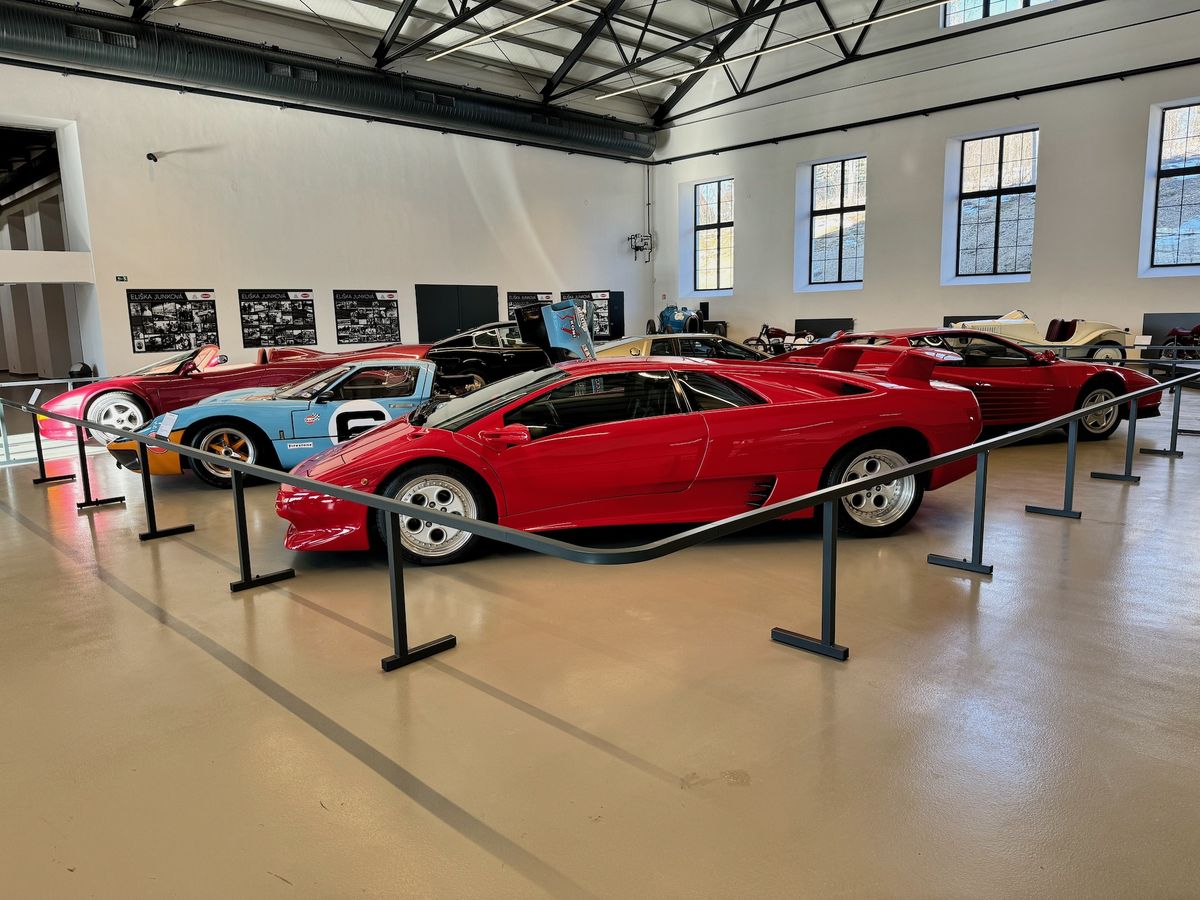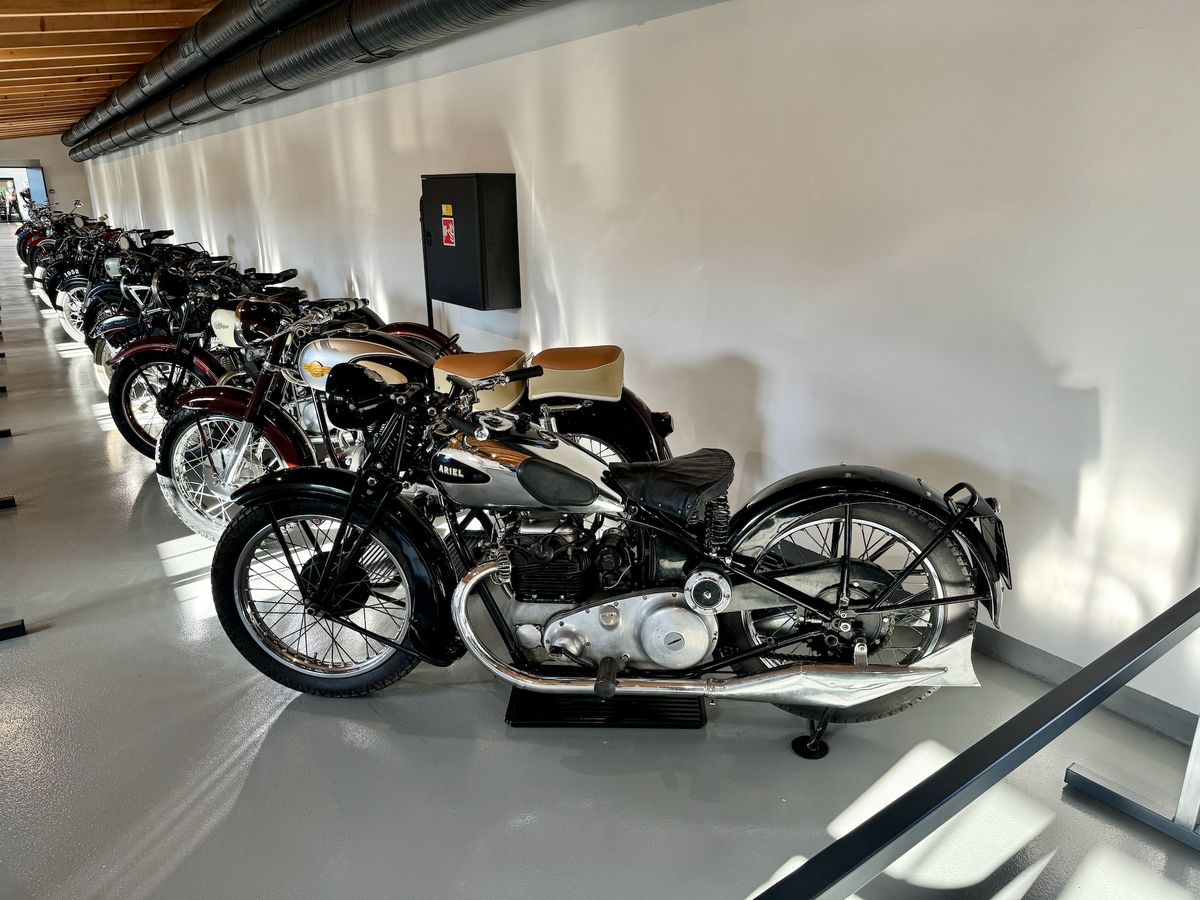Automoto Museum Lučany was officially opened last November as a purely private project without subsidies. The owner of the museum looked at the building of the former glassworks, which was in a state of disrepair, and reconstructed it for about five years.

Photo: Jan Majurník
Automoto Museum Lučany is open from November 2023.
The result was originally supposed to be a deposit for cars with the possibility of visiting a closed company, but in the end it was decided to open a multifunctional museum, where the exhibits can also be rotated thanks to the loan system. I.e. if you have an interesting car and want to display it, do not hesitate to contact the museum.
The whole concept of the Lučan museum is guided in a sporting direction with an overlap into racing, so you will find exhibits from the beginning of the 20th century and ending sometime in 2007.
Czech mystery
It is therefore not surprising that right after you climb the main stairs, you will see the racing Ford GT40, the admired and feared Lamborghini Diablo, the famous Ferrari Testarossa and the sibling model of the Tatra V8 MTX with the mysterious name Innotech Mysterro by the designer Václav Král, which was intended for California, but in the end it was created in one single piece.

Photo: Jan Majurník
The Innotech Mysterro has no roof because it was designed for sunny California.
You should not miss the Dakar section, which is full of motorcycles, with one exception (Toyota 4runner, which conquered the Dakar Rally in 1991). However, even here you will find a current Czech trace, namely a motorcycle that was built by Ondřej Klymčiw’s team (Škodovka project for the Dakar) for Gábina Novotná, who did not complete the Dakar with it.

Photo: Jan Majurník
In the corner of Dakar, you will find a machine built by Ondra Klymčiwa’s team.
However, there is another Novotná motorcycle built by Jan Veselý right next to it, on which the completion of the Dakar was already celebrated.

Photo: Jan Majurník
There are two NSXs here, one Honda and one American Acura.
Purely racing cars, for example the rally Škoda 130 LR, which was driven by Břetislav Enge and Tomáš Enge, lives here. Next to it stands the original Peugeot 206 WRC and the Ducati Desmosedici motorcycle, which is the de facto MotoGP machine on the brands.
One corner of the museum is always dedicated to a thematic collection, and during our visit we were able to recall the creations of the British John Cowperthwaite, who designed and produced affordable kit-cars (building blocks), specifically replicas of various sports cars.

Photo: Jan Majurník
During our visit, the themed corner was dedicated to John Cowperthwaite.
Other interesting cars include, for example, the Tatra 605, Tatra 12 Sport or the rare Bugatti 37 GP, which Eliška Junková herself once said looked as if a painter had drawn it with one stroke of a brush.
Racing motomania
You will also find many motorbikes on site. We have selected three interesting ones, but if you are a biker, you will be in paradise here and you will discover far more rarities.
We’re interested in the 1938 DKW SS 250 Lade Pumpe, a motorcycle that uses a two-stroke, liquid-cooled, two-piston single cylinder that is supercharged by an internal piston supercharger.

Photo: Jan Majurník
The motorcycle is really a full backpack in the museum and each one is different.
It is said that this bike roared so much during the Tourist Trophy races on the Isle of Man that it could be heard as far as 80 km away in England. According to information from the museum, 200 of these machines were produced.
The next motorcycle represents a milestone for the domestic motorcycle industry, as it is the first ever production model of the then young Jawa motorcycle brand. It was founded by František Janeček, who worked in the arms industry, but it did not flourish, so he licensed the German motorcycle prototype Wanderer and the Jawa 500 OHV was created.

Photo: Jan Majurník
From 1959, Jawa competition motorcycles were prepared at a branch plant in Libni.
But this motorcycle was heavy, expensive, and also blessed with structural defects, so it soon earned the unflattering nickname of the rumpus.
But did you know that Jawa also made off-road machines? The proof is the all-terrain racing vehicle Jawa 250 type 553 nicknamed libeňák. It was called that because Jawa competition motorcycles were prepared in a branch plant in Prague’s Libni from 1959. In addition, racing jaws won almost everything that could be won back then.
Secret Chambers
We also looked into places where you don’t normally go. Specifically, it was a lounge where various events and meetings take place and where red legends such as the Acura NSX, Ferrari 360 Modena or Alfa Romeo SZ (Sprint Zagato) stand. These cars definitely create a pleasant atmosphere.

Photo: Jan Majurník
In the lounge there are five red sportsmen at the head of a Ferrari 360.
Another place are workshops where cars and motorbikes are serviced and repaired, where the general public can have their pet repaired. The last room, where you are probably not normally allowed, is the depository, where interested parties can have their vehicles stored in a clean and dry place.
And that there were interesting things inside! Be it the Volkswagen T1, the Renault Clio V6 (yes, the beast with the engine behind the front seats), the BMW 850 CSI or the Porsche 911. In short, a toy store for big boys.
But back to the museum, where until now work has been done to fill it with exhibits, while now a wider informative shot and decoration/graphics of the hitherto white walls will come to the fore. Those interested in a deeper knowledge of individual cars or sections can look forward to a detailed history and points of interest.

Photo: Jan Majurník
Automoto Museum Lučany (by the way, the Kaipan car factory is also located nearby) is full of stories and you can visit it on Fridays from 4 to 9 p.m. and on weekends from 10 a.m. to 6 p.m. From Monday to Thursday, you can take advantage of paid tours commented by an expert, but you need to order in advance via the museum’s website.
The basic entrance fee is CZK 230, the student ticket is CZK 160, and for children, seniors over 70 and ZTP holders, the ticket costs CZK 100. The family entrance fee will then cost 280 CZK, i.e. 560 CZK, depending on the number of members. These prices apply when buying tickets online, they are slightly more expensive on the spot. With the so-called Harrachov Card, you can get in even more advantageously. This museum is really worth a visit, we can recommend it.



